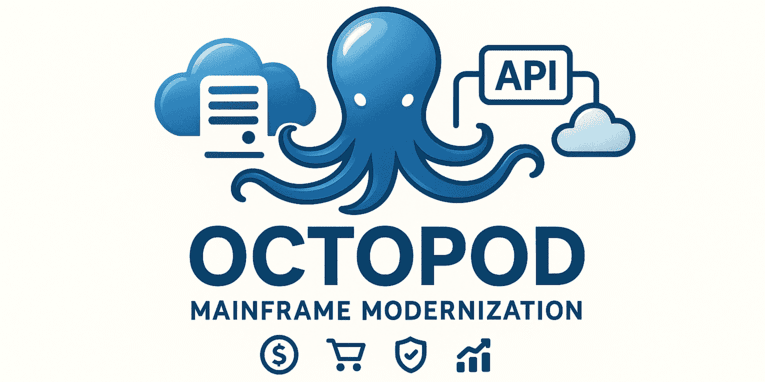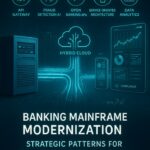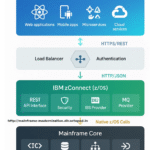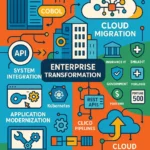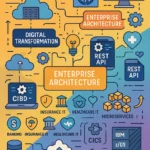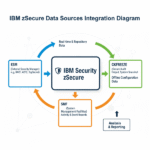If you’re searching for a guide to mainframe modernization that goes beyond vendor promises, stop what you’re doing and read Barry Ryan’s “Slaying the Dinosaur: on migrating off an IBM mainframe” on LinkedIn. This isn’t just another theoretical piece—it’s one of the best success stories for mainframe modernization you’ll find anywhere, written by someone who actually executed the transformation.
Ryan’s account of migrating Irish Life’s CLOAS system from IBM mainframe to Windows between 2009-2013 provides the mainframe modernization how-to roadmap that’s desperately missing from most literature. More importantly, it addresses the critical question every CTO asks: where to migrate the mainframe and how to avoid becoming another failure of modernization mainframe statistic.
What Makes This the Ultimate Mainframe Modernization Guide
This isn’t your typical overview article. Ryan’s story provides actionable insights into how to modernize the mainframe with real mainframe modernization time estimates based on actual project delivery. The Irish Life team spent four years (2009-2013) executing their transformation, providing realistic benchmarks for your planning.
Honest Risk Assessment: The Foundation of Success
The project started with a 25% chance of success and a willingness to write off €250,000 if the proof of concept failed. This psychological safety—the organizational willingness to fail—created the foundation for what would become one of the most compelling success stories for mainframe modernization.
Understanding realistic mainframe modernization time estimates starts here: Irish Life invested significant time in feasibility studies before full commitment. Too many organizations underestimate this crucial phase, leading to the common failure of modernization mainframe projects we document elsewhere.
Technical Depth: COBOL Modernization in Practice
Ryan’s article excels at explaining COBOL modernization without oversimplifying. The CLOAS system was written in COBOL from the 1970s—exactly the challenge most organizations face today. Rather than attempting complete rewrites, the team focused on how to modernize the mainframe infrastructure while preserving valuable COBOL business logic.
The team didn’t just migrate COBOL code; they transformed batch processing from 11-hour windows to under 2 hours while cutting infrastructure costs by 80%. This COBOL modernization approach proves you don’t need to throw away decades of business logic to achieve modern performance.
Industrial Testing: The Methodology That Prevents Failure
Ryan describes “industrial testing”—parallel running huge volumes of transactions and automatically comparing outputs. This methodology proved crucial for avoiding the failure of modernization mainframe projects. The approach validates every component before cutover, building confidence incrementally rather than betting everything on a single migration weekend.
The Success Story: Results That Define Modern Best Practices
When CLOAS Nua went live on February 15, 2013, Irish Life achieved outcomes that every guide to mainframe modernization should highlight:
- 80%+ infrastructure cost reduction compared to legacy operations
- Batch processing times reduced from 11 hours to under 2 hours
- Capacity to scale from 650,000 to over 1 million policies without hardware upgrades
- Modernized skills profile for COBOL modernization: transitioning from COBOL/IMS to COBOL/C#/SQL Server
- Reusable automation and CI/CD capabilities rare in systems of record
- Successful replication by sister company IPSI in under 12 months
These results make Irish Life’s story one of the definitive success stories for mainframe modernization, proving that disciplined execution delivers transformational outcomes.
Mainframe Modernization How To: Addressing Today’s Critical Challenges
Ryan’s 2009-2013 success story provides a comprehensive mainframe modernization how-to guide by addressing the four critical challenges facing projects today, as we outlined in our analysis of common migration failures and lessons learned.
The Documentation Problem: Foundation of How to Modernize the Mainframe
Every guide to mainframe modernization must address documentation gaps. Ryan’s team faced legacy COBOL code from the 1970s with uncertain documentation—exactly what modern projects encounter. Their comprehensive code analysis approach—understanding dependencies, mapping data flows, reverse-engineering business logic—provides the blueprint for how to modernize the mainframe when documentation is incomplete.
They didn’t have today’s AI-powered tools like IBM Watson Code Assistant or Google’s Mainframe Assessment Tool, which makes their manual achievement even more impressive. Modern organizations have advantages Irish Life lacked, yet the fundamental principle remains: you can’t execute COBOL modernization without first understanding what you have.
The lesson for mainframe modernization how-to: invest heavily in discovery and analysis before making architectural decisions about where to migrate the mainframe.
The Skills Gap: COBOL Modernization Without Losing Expertise
Irish Life navigated COBOL modernization elegantly. Rather than trying to retrain everyone or hire mythical “mainframe-to-cloud” unicorns, they created a hybrid environment where existing COBOL developers could learn SQL Server while maintaining their core expertise.
This approach to COBOL modernization demonstrates how to modernize the mainframe without destroying institutional knowledge. The shift from IMS to SQL Server—while keeping COBOL as the application language—represented a manageable learning curve rather than complete skills revolution.
Any comprehensive guide to mainframe modernization must address talent strategy. Irish Life’s approach proves you don’t need to choose between legacy expertise and modern skills—you need both, working together.
The Migration Destination: Where to Migrate the Mainframe
One of the most critical decisions in any mainframe modernization how-to guide is answering: where to migrate the mainframe? Irish Life chose Windows and SQL Server, but the decision process matters more than the specific destination.
Irish Life evaluated multiple options before selecting their target platform:
- Windows/SQL Server: Chosen for cost reduction and skills availability
- Oracle/AIX: ANZ had successfully migrated CLOAS to this platform
- Cloud platforms: Not mature in 2009, but now viable options
Today, organizations asking where to migrate the mainframe have additional options:
- Public cloud (AWS, Azure, Google Cloud) with managed services
- Private cloud with containerization
- Hybrid architectures combining on-premise and cloud
- Microservices architectures for gradual decomposition
The decision about where to migrate the mainframe should consider cost, skills availability, vendor support, performance requirements, and regulatory constraints. Irish Life’s methodology for evaluating options provides a template for modern decision-making.
API Strategy: Modern Integration Patterns
While not explicitly detailed in Ryan’s 2009 account, the API mainframe integration question is crucial for modern transformations. Irish Life’s approach maintained COBOL business logic while modernizing the surrounding infrastructure—essentially creating service boundaries that today would be implemented as APIs.
Modern mainframe modernization how-to guides must address API mainframe integration strategies:
- API wrappers around existing COBOL programs
- Service-oriented architecture exposing mainframe functions
- Event-driven integration using message queues
- REST/GraphQL APIs for modern application integration
The API mainframe approach allows gradual modernization without big-bang rewrites, aligning with Irish Life’s phased methodology.
Microservices Strategy: Decomposition Approach
Today’s guide to mainframe modernization must address microservice mainframe modernization—an approach that wasn’t mainstream in 2009 but aligns perfectly with Irish Life’s principles. The team’s focus on modular problem-solving and incremental delivery maps directly to microservice mainframe modernization patterns.
Microservice mainframe modernization strategies include:- Strangler pattern: Gradually replace mainframe components with microservices
- Service extraction: Identify bounded contexts and extract them
- API-first approach: Create microservices that consume mainframe APIs
- Event-driven architecture: Decouple systems using event streams
Ryan’s emphasis on “chunking down” problems and solving them sequentially describes exactly how microservice mainframe modernization should work. Rather than attempting complete rewrites, decompose the monolith systematically.
The Irish Life approach to COBOL modernization—preserving business logic while modernizing infrastructure—aligns with microservice mainframe modernization best practices. You don’t need to rewrite everything; you need to extract and modernize strategically.
Time Estimates: Realistic Mainframe Modernization Time Estimates
One of the most valuable aspects of Ryan’s article is providing realistic mainframe modernization time estimates. Too many success stories for mainframe modernization gloss over actual timelines, leading organizations to underestimate efforts and setting up failure of modernization mainframe projects.
Irish Life’s actual mainframe modernization time estimates:
- 2009: Initial discussions and feasibility assessment (6 months)
- 2010: Proof of concept with €250k investment (6-9 months)
- 2011: Full project commitment and development (12 months)
- 2012: Integration, testing, and parallel runs (12 months)
- 2013: Cutover and production stabilization (3 months)
These mainframe modernization time estimates provide realistic benchmarks. Any guide to mainframe modernization promising faster timelines should be viewed skeptically. While modern tools (AI-powered code analysis, cloud platforms, containerization) can accelerate some phases, the fundamental work—understanding systems, validating transformations, building confidence—requires time.
Compare Irish Life’s mainframe modernization time estimates to industry benchmarks:
- Small systems (< 1 million lines of code): 18-24 months
- Medium systems (1-5 million lines): 2-4 years
- Large systems (5+ million lines): 4-7 years
Irish Life’s CLOAS system fell into the medium category, and their 4-year timeline aligns with these realistic mainframe modernization time estimates.
Cost and Budget Reality
Realistic mainframe modernization time estimates must include budget considerations. Irish Life’s phased investment approach addressed cost uncertainty:
- Phase 1: €250k proof of concept (high-risk investment)
- Phase 2: €1M+ full implementation (committed after POC success)
- Total: Significant investment generating 80% ongoing cost reduction
Any mainframe modernization how-to guide must acknowledge that transformations require substantial investment before generating returns. Organizations seeking success stories for mainframe modernization should note that Irish Life’s willingness to write off the initial €250k if POC failed exemplifies the risk tolerance required.
Universal Lessons: Building Your Guide to Mainframe Modernization
Ryan’s “Lessons Learned” section provides essential components for any guide to mainframe modernization.
Executive Sponsorship Drives Success
Every guide to mainframe modernization must emphasize executive sponsorship. Without vision from Denis McLoughlin and Bobby Scannell, and support from Group CIO Brendan Healy, Irish Life’s project would have remained an interesting idea. The difference between success stories for mainframe modernization and failure of modernization mainframe often comes down to sustained leadership commitment.
Technical projects answering how to modernize the mainframe need business champions who understand both risks and rewards, especially when mainframe modernization time estimates span multiple years.
Psychological Safety Enables Innovation
The organization’s willingness to write off the initial investment if it didn’t work created freedom to innovate. This psychological safety appears consistently in success stories for mainframe modernization but is absent in failure of modernization mainframe cases.
When teams fear failure, they become conservative and miss opportunities for COBOL modernization or microservice mainframe modernization that might actually work.
Early Wins Build Organizational Confidence
Every mainframe modernization how-to strategy should include early wins. Irish Life replatformed ancillary systems before tackling CLOAS itself, building confidence and proving methodology before risking critical systems.
This approach to how to modernize the mainframe builds momentum and earns credibility for subsequent phases—critical when mainframe modernization time estimates span years.
Clear Goals Provide Direction
“Implement or develop solutions for every component that were as good as or better than their mainframe counterparts.” This clarity appears in success stories for mainframe modernization but is absent in failure of modernization mainframe projects.
Your guide to mainframe modernization needs equally clear success criteria, whether you’re pursuing COBOL modernization, microservice mainframe modernization, or complete platform replacement.
Sequential Problem-Solving Works
Ryan’s emphasis on solving one problem at a time provides the blueprint for mainframe modernization how-to execution. Batch performance first, then data migration, then operational procedures—sequential problem-solving that made the insurmountable manageable.
This approach applies whether you’re implementing API mainframe integration, microservice mainframe modernization, or traditional migration. Don’t try to solve everything simultaneously.
Cross-Functional Collaboration Multiplies Results
Every guide to mainframe modernization should emphasize collaboration. Irish Life’s success came from people willing to work outside traditional silos—a pattern appearing in success stories for mainframe modernization but absent in failure of modernization mainframe cases.
Modern approaches like microservice mainframe modernization require even more collaboration across development, operations, architecture, and business stakeholders.
Where to Migrate the Mainframe: Evaluating Options
A comprehensive guide to mainframe modernization must address where to migrate the mainframe with detailed evaluation criteria.
Cloud Platform Options
Today’s answer to where to migrate the mainframe often involves cloud platforms:
AWS Mainframe Modernization Services:- Automated refactoring with BluAge
- Managed runtime environments
- Integration with AWS services
- Best for organizations with AWS expertise
- Integration with Microsoft ecosystem
- Windows-based (like Irish Life’s choice)
- Strong SQL Server integration
- Ideal for Microsoft-centric organizations
- AI-powered assessment tools
- Container-based runtimes
- BigQuery for analytics
- Strong for data-intensive workloads
On-Premise Modern Platforms
where to migrate the mainframe doesn’t always mean cloud: Linux/Unix Platforms:- Open systems architecture
- Cost reduction like Irish Life achieved
- Skills availability
- Containerization support
- Familiar environment for many organizations
- Strong tooling ecosystem
- Microsoft support
- SQL Server integration
Hybrid Approaches
Modern mainframe modernization how-to guides should consider hybrid strategies:
Mainframe + Cloud:- Keep core systems on mainframe
- New capabilities in cloud
- API mainframe integration connecting them
- Gradual migration over time
- Microservice mainframe modernization extracting components
- Core remaining on mainframe temporarily
- New services in modern platforms
- Service mesh connecting everything
The decision about where to migrate the mainframe should balance:
- Cost reduction potential
- Skills availability
- Performance requirements
- Regulatory constraints
- Vendor support
- Integration complexity
How to Modernize the Mainframe: Practical Implementation
This section provides tactical mainframe modernization how-to guidance based on Irish Life’s experience.
Phase 1: Assessment and Planning (3-6 months)
Every guide to mainframe modernization should start with thorough assessment:
Discovery Activities:- Code analysis (automated tools now available)
- Dependency mapping
- Data flow documentation
- Integration point identification
- Skills assessment
Irish Life spent significant time here, providing realistic mainframe modernization time estimates for your planning.
Planning Decisions:- Where to migrate the mainframe (platform selection)
- COBOL modernization approach (preserve, refactor, or rewrite)
- Microservice mainframe modernization strategy (if applicable)
- API mainframe integration patterns
- Resource allocation
Don’t rush this phase. The difference between success stories for mainframe modernization and failure of modernization mainframe often traces back to inadequate planning.
Phase 2: Proof of Concept (6-9 months)
Every mainframe modernization how-to should include POC validation:
POC Objectives:- Validate where to migrate the mainframe decision
- Test COBOL modernization approach
- Prove API mainframe integration patterns
- Validate performance assumptions
- Refine mainframe modernization time estimates
Irish Life invested €250k in POC with willingness to walk away if unsuccessful. This risk tolerance characterizes success stories for mainframe modernization.
POC Success Criteria:- Batch performance meets requirements
- Data integrity validated
- Integration patterns proven
- Skills transfer successful
- Cost models validated
Phase 3: Infrastructure Setup (3-6 months)
Platform Preparation:- Target environment setup
- Tool installation and configuration
- Development environment creation
- CI/CD pipeline establishment
- Monitoring and logging infrastructure
For microservice mainframe modernization, this includes container orchestration platforms, service mesh setup, and API gateway configuration.
Phase 4: Migration Execution (12-18 months)
How to modernize the mainframe execution phase: Code Migration:- COBOL modernization execution (automated where possible)
- Testing and validation
- Performance optimization
- Documentation creation
- Schema conversion
- Data transformation and validation
- Parallel running
- Cutover planning
- API mainframe connections established
- Microservice mainframe modernization components deployed
- End-to-end testing
- Performance validation
Phase 5: Testing and Validation (6-12 months)
Irish Life’s “industrial testing” approach should be central to any guide to mainframe modernization:
Parallel Running:- Process transactions on both systems
- Automated comparison of results
- Issue identification and resolution
- Confidence building
This testing phase prevents failure of modernization mainframe projects by catching issues before production cutover.
Phase 6: Cutover and Stabilization (2-4 months)
Final phases of mainframe modernization how-to:
Cutover Planning:- Timing selection
- Rollback procedures
- Communication plans
- Support team preparation
- Production monitoring
- Issue resolution
- Performance optimization
- Documentation updates
These mainframe modernization time estimates (total: 30-50 months for medium complexity) align with Irish Life’s 4-year timeline and provide realistic planning guidance.
API Mainframe Integration: Modern Connectivity
While not explicitly in Ryan’s 2009 story, modern guide to mainframe modernization must address API mainframe strategies.
API Gateway Patterns
API mainframe integration typically uses: REST API Wrappers:- Expose COBOL programs as REST services
- Modern applications consume mainframe logic
- Gradual modernization without rewrites
- Supports microservice mainframe modernization
- Unified API layer across mainframe and modern systems
- Flexible querying
- Better developer experience
- Gradual schema evolution
Event-Driven Integration
Modern API mainframe strategies include:
Message Queues:- Asynchronous communication
- Decoupled systems
- Better scalability
- Fault tolerance
- Real-time data flow
- Change data capture
- Analytics enablement
- Supports microservice mainframe modernization
The API mainframe approach allows how to modernize the mainframe incrementally rather than requiring big-bang cutover—aligning with Irish Life’s phased methodology.
Microservice Mainframe Modernization: Decomposition Strategy
Modern guide to mainframe modernization increasingly includes microservice mainframe modernization approaches.
Strangler Pattern
Microservice mainframe modernization using strangler pattern: Phase 1: Identify Boundaries- Analyze COBOL code for bounded contexts
- Map business capabilities
- Identify extraction candidates
- Plan service boundaries
- Implement API mainframe wrappers
- Route traffic through facades
- Enable gradual replacement
- Maintain system stability
- Implement microservices with same functionality
- Gradually redirect traffic
- Retire mainframe components
- Continuous validation
- All functionality in microservices
- Mainframe fully decommissioned
- Modern architecture achieved
- Ongoing evolution enabled
Service Extraction Patterns
Microservice mainframe modernization service extraction: Business Logic Extraction:- Identify cohesive business functions
- Extract to microservices
- Maintain COBOL modernization where appropriate
- Gradual transformation
- Split monolithic databases
- Service-specific data ownership
- Eventual consistency patterns
- Data synchronization strategies
The microservice mainframe modernization approach aligns perfectly with Irish Life’s “chunk it down” principle—solving one service at a time rather than attempting everything simultaneously.
COBOL Modernization: Preserving Business Logic
A practical guide to mainframe modernization must address COBOL modernization specifically.
COBOL Preservation Strategies
Irish Life’s approach to COBOL modernization was pragmatic:
Keep COBOL Where It Makes Sense:- Stable business logic
- Well-tested code
- Limited changes needed
- Skills available
- Move from IMS to SQL Server
- Modern development tools
- Better debugging environment
- CI/CD integration
This COBOL modernization approach appears in many success stories for mainframe modernization—preserve valuable business logic while modernizing surrounding infrastructure.
COBOL Translation Options
Modern COBOL modernization options:
Automated Translation:- AI-powered tools (IBM Watson, AWS BluAge)
- COBOL to Java/C#/Python
- Faster than manual rewrites
- Quality varies
- Complete redesign
- Modern languages and patterns
- Highest quality potential
- Longest mainframe modernization time estimates
- Automated translation foundation
- Manual refinement
- Balanced speed and quality
- Realistic mainframe modernization time estimates
The choice affects mainframe modernization time estimates significantly—automated approaches might save 40-60% of development time.
Success Stories vs Failure: Learning from Both
Understanding both success stories for mainframe modernization and failure of modernization mainframe patterns helps create your guide to mainframe modernization.
Characteristics of Success Stories
Success stories for mainframe modernization share common patterns: Executive Support:- Sustained leadership commitment
- Adequate funding
- Patience with mainframe modernization time estimates
- Willingness to fail and learn
- Thorough discovery and analysis
- Realistic mainframe modernization time estimates
- Comprehensive testing
- Incremental approach
- Psychological safety
- Cross-functional collaboration
- Skills development
- Clear success criteria
Irish Life exhibits all these characteristics, making it exemplary among success stories for mainframe modernization.
Common Failure Patterns
Failure of modernization mainframe projects typically show: Inadequate Planning:- Rushed assessment
- Unrealistic mainframe modernization time estimates
- Poor understanding of dependencies
- Insufficient analysis
- Inadequate testing
- Big-bang cutover attempts
- Ignoring integration complexity
- Overlooking COBOL modernization challenges
- Lack of executive support
- Fear-based culture
- Siloed teams
- Unclear success criteria
Understanding failure of modernization mainframe patterns helps you avoid becoming another cautionary tale. Our detailed analysis of common failures provides additional patterns to avoid.
Practical Application: Your Complete Guide
This guide to mainframe modernization synthesizes Irish Life’s experience into actionable steps for how to modernize the mainframe.
Assessment Phase Checklist
Technical Assessment:- [ ] Complete code inventory (COBOL, JCL, etc.)
- [ ] Dependency mapping
- [ ] Data architecture documentation
- [ ] Integration point identification
- [ ] Performance baseline establishment
- [ ] Stakeholder identification
- [ ] Success criteria definition
- [ ] Budget estimation
- [ ] Mainframe modernization time estimates
- [ ] Risk assessment
- [ ] Where to migrate the mainframe decision
- [ ] COBOL modernization approach
- [ ] Microservice mainframe modernization evaluation
- [ ] API mainframe integration strategy
- [ ] Skills development plan
Execution Phase Framework
How to modernize the mainframe execution: Phase 1: POC (6-9 months)- Validate platform choice
- Test COBOL modernization approach
- Prove API mainframe patterns
- Refine estimates
- Platform setup
- Tool configuration
- CI/CD establishment
- Team training
- Incremental code migration
- Continuous testing
- Integration development
- Documentation
- Industrial-scale testing
- Parallel running
- Issue resolution
- Confidence building
- Production migration
- Monitoring
- Stabilization
- Knowledge transfer
Success Metrics
Measure your guide to mainframe modernization success:
Technical Metrics:- Batch processing time reduction
- Infrastructure cost savings
- System availability
- Performance improvements
- Time to market for new features
- Development productivity
- Operational efficiency
- Risk reduction
- Skills profile modernization
- Team satisfaction
- Recruitment success
- Knowledge retention
Irish Life achieved 80% cost reduction, 80%+ batch time improvement, and successful skills transition—benchmark metrics for your success stories for mainframe modernization.
The Bottom Line: Your Path to Success
This guide to mainframe modernization demonstrates that success is achievable. Barry Ryan’s article provides the mainframe modernization how-to blueprint, showing exactly how to modernize the mainframe through disciplined execution.
The key insights for your guide to mainframe modernization:
Realistic Planning:- Use accurate mainframe modernization time estimates (3-5 years for medium systems)
- Plan adequate budget and resources
- Build executive support
- Create psychological safety
- Determine where to migrate the mainframe carefully
- Choose appropriate COBOL modernization approach
- Evaluate microservice mainframe modernization fit
- Design API mainframe integration strategy
- Follow proven mainframe modernization how-to methodology
- Implement industrial-scale testing
- Deliver incremental value
- Build organizational confidence
- Study both success stories for mainframe modernization and failure of modernization mainframe patterns
- Learn from Irish Life’s experience
- Avoid common pitfalls
- Adapt proven patterns to your context
Making This Your Guide to Mainframe Modernization
Transform this article into your organization’s guide to mainframe modernization:
For Executives:Understanding mainframe modernization time estimates, budget requirements, and organizational prerequisites. Irish Life’s 4-year journey and €1M+ investment provide realistic benchmarks.
For Architects:Detailed patterns for where to migrate the mainframe, API mainframe integration, microservice mainframe modernization, and COBOL modernization strategies.
For Project Managers:Proven mainframe modernization how-to methodology with phase breakdowns, realistic mainframe modernization time estimates, and risk management approaches.
For Developers:Practical COBOL modernization techniques, API mainframe implementation patterns, and microservice mainframe modernization strategies.
Learn from Success and Failure
This guide to mainframe modernization draws on two essential resources. First, Barry Ryan’s detailed account of Irish Life’s successful migration provides the success stories for mainframe modernization blueprint. Second, our analysis of common migration failures identifies failure of modernization mainframe patterns to avoid.
Together, these resources provide a complete framework for how to modernize the mainframe. Success requires learning from both what works and what doesn’t, understanding technical and organizational dimensions, and committing to disciplined execution.
The market is growing rapidly because organizations finally have mature tools addressing critical challenges. Companies winning at transformation acknowledge obstacles upfront, use realistic mainframe modernization time estimates, make informed decisions about where to migrate the mainframe, and deploy appropriate COBOL modernization, API mainframe, and microservice mainframe modernization strategies from day one.
Start your journey by using this guide to mainframe modernization to assess challenges in your environment. Which documentation gaps exist? What’s your talent situation? Have you decided where to migrate the mainframe? What’s your COBOL modernization strategy? Are you considering microservice mainframe modernization? What are realistic mainframe modernization time estimates for your scope?
Answer these questions accurately using this mainframe modernization how-to framework, and you’re halfway to joining the success stories for mainframe modernization. Ignore them, and you risk becoming another failure of modernization mainframe cautionary tale.
The choice is yours. This guide to mainframe modernization shows the path. The tools exist. The solutions work. The question is whether you’ll apply this mainframe modernization how-to strategically—or learn expensive lessons the hard way.
